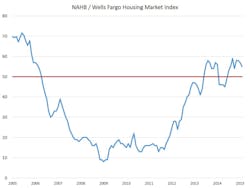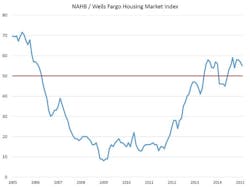Housing and Residential Construction Off to Slow Start in 2015
Housing and residential construction is off to a slow start this year, according to the National Association of Home Builders. January data have been disappointing, although current indicators continue to suggest home building will grow in the year ahead. In particular, solid job growth and historically low mortgage rates should help unleash growing pent-up demand and keep the housing market moving forward.
Home builder confidence in the market for newly built, single-family homes fell two points to 55 on the NAHB/Wells Fargo Housing Market Index in February. Builder sentiment remains fairly solid, with this slight downturn largely attributable to harsh weather conditions.
For the past eight months, HMI-reported confidence levels have held in the mid- to upper 50s range, which is consistent with a modest, ongoing recovery.
The pace of housing starts declined 2% in January, including a significant decrease in single-family construction in the Midwest connected to weather factors. According to the joint Census Bureau and HUD release, the seasonally adjusted annual rate of housing starts came in at 1.065 million, down from a revised pace of 1.087 million in December 2014.
The rate of starts for single-family construction was down 6.7% from December, yielding a 678,000 annual pace. Most of this decline is attributable to a 31% drop for single-family starts in the Midwest, which fell from a 133,000 annual rate in December to 92,000 in January.
Multifamily starts remained strong in January, rising 7.5% to a 387,000 seasonally adjusted annual rate. The three-month moving average of multifamily starts has been above 350,000 since April 2014.
Consistent with other housing data, existing home sales were down in January, declining 4.9% although up 3.2% from a year ago. The National Association of Realtors reported January existing home sales at a seasonally adjusted rate of 4.82 million units combined for single-family homes, townhomes, condominiums and co-ops, down from a revised 5.07 million units in December.
The first-time buyer share decreased to 26% in January, down from 29% in December and 31% in November. This continuing downward trend follows 2014, when the annual share of first-time buyers fell to its lowest level in nearly three decades.
Despite the spate of negative news for January, other economic reports pointed to more positive conditions ahead. New home sales in January declined negligibly from an elevated, 482,000 seasonally adjusted annual rate in December to 481,000. The January estimates saw a 50% drop in the Northeast on weather-related factors (from a 31,000 rate in December to 15,000 in January). In spite of that regional decline, the national sales rate was effectively unchanged from the post-recession high point for new single-family home sales.
Housing affordability, as measured by the NAHB/Wells Fargo Housing Opportunity Index, increased at the end of 2014. In all, 62.8% of new and existing homes sold between the beginning of October and end of December were affordable to families earning the median income of $63,900. Moreover, households appear ready to borrow to make a home purchase, when they qualify for a mortgage and can save for a downpayment.
For builders, AD&C lending conditions continue to improve, although debt access remains a roadblock to a more robust recovery. An NAHB quarterly survey of debt conditions indicates that more builders are reporting loosening conditions for AD&C loans. Consistent with this survey, data from the FDIC reveal that the volume of outstanding AD&C loans for home building purposes has grown for seven consecutive quarters and has increased 17% year over year as of the final quarter of 2014.
Looking at various home building submarkets for the final quarter of 2014 reveals some possible trends to watch in 2015. Median single-family home size stopped growing in 2014, and actually posted a small decline, perhaps indicating an end to the ahistorical market shift to higher end buyers. As an example of that shift, custom home building was up 20% in 2014 over the prior year.
The townhouse share of the single-family market grew slightly at the end of 2014. This market should see additional growth as younger buyer enter the marketplace. Likewise, more condo buyers in the multifamily building sector, currently dominated by for-rent construction (90% of starts), will lead to increases in the typical size of apartments.

